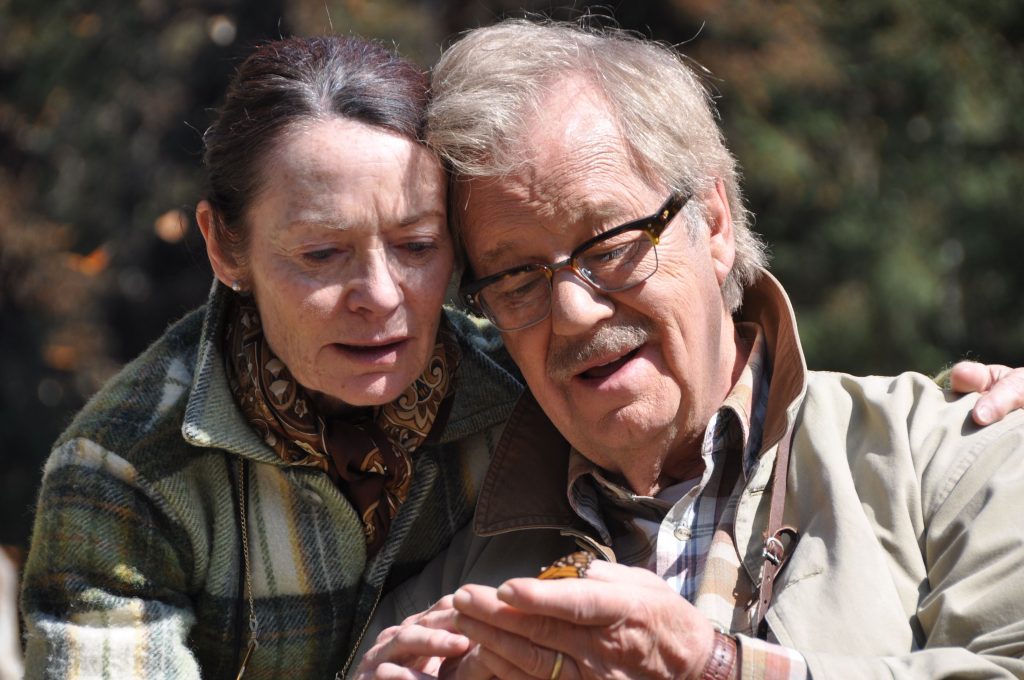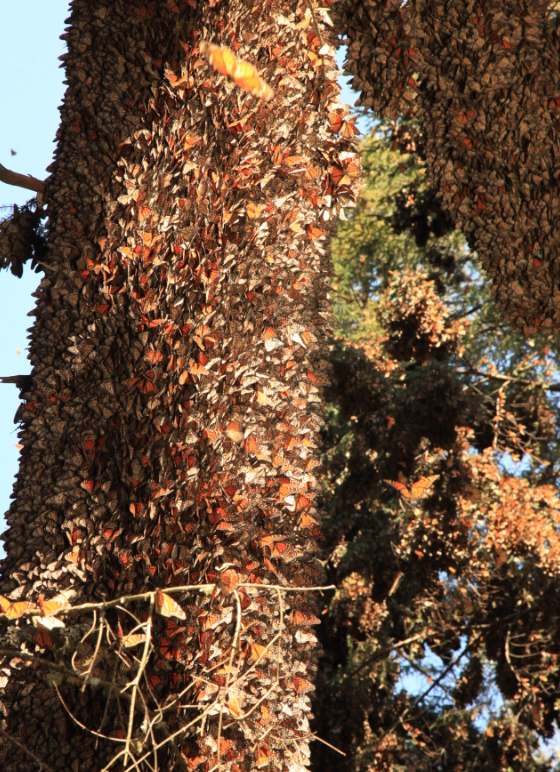The new 3D IMAX film, “Flight of the Butterflies,” made the perfect Thanksgiving Day preface to a nontraditional dinner for my parents, Hilde and John Maeckle, 80 and 91 years young, respectively, and affectionately known as “Oma” and “Opa.”

Thanksgiving Day treat: Flight of the Butterflies in 3D. L-R Hilde, John, and Monika Maeckle –Photo by Robert Rivard
Apart from the fantastic story and stunning effects, the sound was loud enough for my hard-of-hearing dad to enjoy the soothing rhythm of millions of butterflies’ wings beating. The three-dimensional cinematography so captured his imagination that he, like the rest of us, couldn’t resist reaching into the darkness in attempts to touch the butterflies as they seemingly flit before our eyes.
This familiar story, well-told, never gets old–even to a butterfly evangelist well-versed in Monarch butterfly natural history. Only one scene gave me pause, making me wonder if the filmmakers had taken their cinematic license too far.
The film weaves the compelling narrative of Dr. Fred Urquhart and his wife Norah, who studied the Monarchs for 40 years and are credited with piecing together the mystery of their migration. Their tenacious efforts included the development of the first citizen scientist tagging programs. The climax of the story occurs when the Urquharts finally visit the ancestral roosts in early 1976, after Mexican national Catalina Trail and her husband Ken Brugger lead them to the mountaintop in Michoacan province near Angangueo where the butterflies wait out the winter each year.
The film depicts the elderly couple huffing up a challenging trail, seemingly gasping for air in the thin mountain air. Upon first sight of the forest filled with Monarch butterflies, Dr. Urquhart appears teary.
In his first person account in National Geographic Magazine in August of 1976, Urquhart mentions the possibility that he might perish before seeing the subject of his life’s work. Here’s what he wrote:
“Norah and I are no longer young. At 10,000 feet, as we walked along the mountain crest, our hearts pounded and our feet felt leaden.
The rather macabre thought occurred to me: Suppose the strain proved too much? It would be the ultimate irony to have come this far and then never witness what we’d waited so long to see!”
But Urquhart and Norah lived to see the Monarchs and tell the tale. In the movie, he sits down in a field to absorb the magnificence of millions and millions of butterflies–floating, flitting, fleeing the ancient Oyamel trees as the sun warms them for a midday flight. He looks down to see a tagged butterfly near his feet–thus proving that these butterflies migrated from the United States.
Watching this scene, I couldn’t believe it happened like that. Did it?

In the movie, Flight of the Butterflies, Norah and Fred Urquhart find a tagged butterfly in Michoacan. The real story was even more amazing. Photo courtesy SK Films
“They couldn’t film what really happened.” said Dr. Chip Taylor, founder of Monarch Watch at the University of Kansas at Lawrence and a longtime Monarch butterfly scholar. “A lot of people questioned that scene.” Taylor relayed the real story, an Isaac Newton moment.
“What really happened, he was sitting by a tree, and a branch fell down,” Taylor said by phone. “And one of the butterflies on the branch had the tag on it.” Taylor said the filmmakers couldn’t replicate the situation exactly without harming the butterflies. Deliberately breaking a branch off the tree in the protected sanctuaries where the scene was shot would have been illegal. The tag was applied in Chaska, Minnesota.
Catalina Trail, the only living member of the team that discovered the Monarch roosting spots in Michoacan and who was present at that moment, confirmed the story. “That’s how it happened,” she said by phone from Austin.
As difficult as it is to grasp, branches often break from the weight of millions of butterflies. “It happens all the time,” said Taylor. Each butterfly weighs half a gram. That means 907 butterflies weigh one pound. And a million butterflies weigh 1,102 pounds. The roosting spots can host half a billion butterflies. Do the math.
“It just blows me away,” said Taylor, recalling a trip to the Monarch sanctuaries and an inch-and-a-half round sapling, 20 feet tall, with a sprig of foliage on the branch. “It would literally fold over double from the weight of the butterflies.” And when they flew off, the branch would spring back to an erect posture, he said.

Catalina Trail, January 2, 1975, the day she and Ken Brugger “discovered” the Monarch butterfly overwintering sites. Photo copyright Catalina Trail
Urquhart described the moment on page 173 of the August 1976 edition of National Geographic: “”While we stared in wonder, a pine branch three inches thick broke under its burden of languid butterflies and crashed to earth…..There, to my amazement, was one bearing a white tag!”
Some have suggested that the movie misses a chance to make a strong case for conservation. But one could also argue that that’s a different movie. The film does much more than any other single piece of media to raise awareness of the magic of the Monarch butterfly migration. Once people feel the magic, then doing something constructive to help often follows–like planting milkweed.
Flight of the Butterflies, a spectacular 44-minute show, simultaneously suits children, seniors and all of us in between. The film continues in San Antonio at the Rivercenter IMAX theater and opens at Austin’s Bob Bullock IMAX Theater in January.
Like what you’re reading? Follow butterfly and native plant news at the Texas Butterfly Ranch. Sign up for email delivery in the righthand navigation bar of this page, like us on Facebook, or follow us on Twitter, @monikam.


Leave A Comment